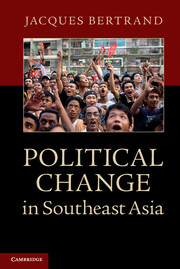Book contents
- Frontmatter
- Contents
- List of figures and tables
- Preface
- 1 Understanding political change in Southeast Asia
- Part I Capitalism, economic growth and political change
- 2 Indonesia and Timor-Leste
- 3 The Philippines
- 4 Malaysia and Singapore
- 5 Thailand
- Part II State-socialist countries and authoritarian stability
- References
- Index
2 - Indonesia and Timor-Leste
Published online by Cambridge University Press: 05 June 2014
- Frontmatter
- Contents
- List of figures and tables
- Preface
- 1 Understanding political change in Southeast Asia
- Part I Capitalism, economic growth and political change
- 2 Indonesia and Timor-Leste
- 3 The Philippines
- 4 Malaysia and Singapore
- 5 Thailand
- Part II State-socialist countries and authoritarian stability
- References
- Index
Summary
Indonesia
In Indonesia, several regime changes have occurred since independence. From 1950–7, Indonesians were governed under a parliamentary democracy. After several crises in the late 1950s, President Sukarno abandoned this regime and proclaimed “Guided Democracy” instead, which was essentially the beginning of authoritarian rule. This regime lasted from 1957–65, and was then replaced with the New Order government of President Suharto, after a failed coup attempt allowed the military to establish a stronger hold on the country. Finally, after thirty-three years, the New Order regime ended when President Suharto resigned in May 1998. His successor, B. J. Habibie, began a process of democratization. Indonesia now constitutes one of the most vibrant electoral democracies of the region, although it continues to be dogged by many problems.
Much of the scholarship on Indonesian politics has attempted to draw continuities across different time periods and regime types, to identify similarities that apparently created some fundamental characteristics in the Indonesian state or practice of politics more broadly. From this scholarship, two kinds of approaches are worth noting: one using the concept of patrimonialism; the other emphasizing cultural practices that are reproduced from one period to the next. These kinds of approaches both emphasize continuities.
- Type
- Chapter
- Information
- Political Change in Southeast Asia , pp. 41 - 70Publisher: Cambridge University PressPrint publication year: 2013



